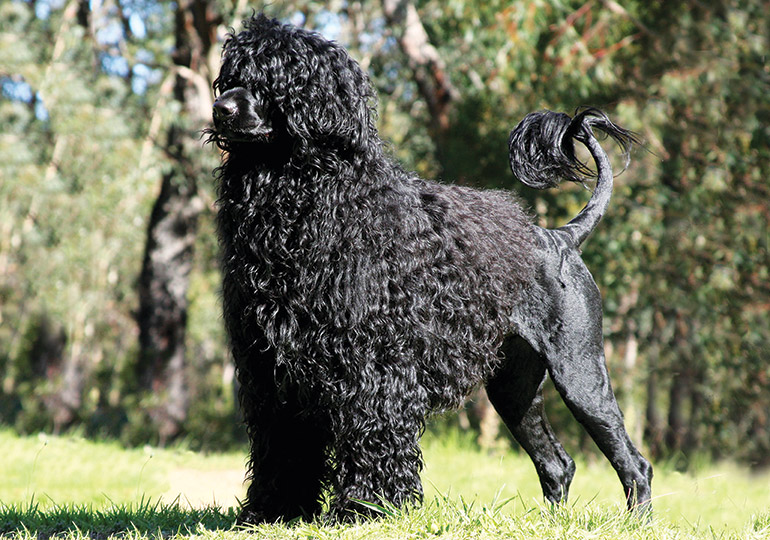Portuguese Water Dog
Breed Details
Size:
Exercise Requirements:
Grooming Requirements:
16-27 Kg (Approx)
11-13 years (Approx)

Appearance
The breed, kept in the true Portuguese Water Dog ‘lion trim,’ would be trimmed from the last rib to the last third of the tail, with the muzzle trimmed from the outside corner of the eye to down under the chin. This was done for their working ability as swimming dogs, herding fish, retrieving lost tackle, untangling nets or acting as couriers from ship to ship or ship to shore.
In Australia a Portuguese Water Dog must be shown in their working trim.
Their coat is single layered hair and is non shedding, making them very suitable to those who suffer allergic reactions to pet fur, or those that just don’t like fur everywhere. There are two types of coats, some being wavy and others curly. The wavy falls gently in waves with a slight sheen. The curly coat has compact cylindrical curls that gives an aphro look and lacks lustre. Both coats still feel quite soft to touch, with the curly having a slightly harsh texture.
History
The Portuguese Water Dog was first described in a monk’s account of a drowning sailor, who was pulled from the sea by a black dog with its hair cut in a lion trim, and became known as a ‘lion dog,’ due to its trim. The hair was cut like this for faster propulsion in the water while keeping the coat over the major body organs, keeping them protected from the sometimes very cold waters. There is a belief that the breed existed as far back as 700BC.
Temperament
The Portuguese Water Dog is a breed that enjoys human company, are highly intelligent and easily trained. They enjoy being close to their owners. They are not a breed that can be left alone for long periods of time without training, stimulation or company.
The Portuguese Water Dog has a multi-octave voice. Some of them are said to “yodel” when excited, especially when greeting a returning master. Although they are not prone to barking excessively, they have a wide range of barks and sighs, as well as an audible “laugh” a loud, irregular, breathy pant used at play or during greetings. This is sometimes called “expressive panting”.
The Portuguese Water Dog makes an excellent watch dog due to its determination to defend its territory with a very loud and distinctive bark. However it will rarely attack an intruder after having given the alarm-barks, so it is not considered a guard dog in the normal sense. In fact, many Portuguese Water Dogs will, without training, bark three or four times then rush to their master’s side to await further instructions on how to relate to a perceived intruder.
The Portuguese Water Dog’s high intelligence, bidability and tendency to vocalise, then seek out its human master when specific alarms occur, is why they are suited to the hearing impaired and can be easily trained.
Care/Grooming
The Portuguese Water Dog's dense, profuse coat is hypoallergenic but requires regular and extensive grooming. The coat ranges in appearance from tight and curly to loose and wavy. It may be kept in the lion clip (where the coat on the hindquarters and muzzle is clipped to the skin) or the retriever clip (where the entire coat is clipped to one inch in length and follows the outline of the dog). Beyond regular weekly grooming, an occasional bath will keep the Portie clean and looking his best.
Breeders
Currently no Breeders in SA for this Breed

